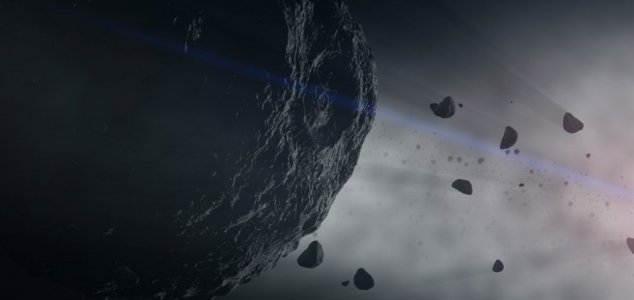Space & Astronomy
March 22, 2018 · 13 comments
13 comments

Could painting an asteroid change its trajectory ? Image Credit: NASA Goddard Conceptual Image Lab
NASA has been showing a keen interest in it as well, having sent its exploratory OSIRIS-REx spacecraft to intercept it, collect a sample of material and then return it to Earth for analysis.
The space agency also recently revealed its work on HAMMER (Hypervelocity Asteroid Mitigation Mission for Emergency Response) - a spacecraft with the potential to intercept and redirect a large incoming asteroid either by ramming it or, if all else fails, by exploding a nuclear bomb.
But what if there was an easier way ? According to Michael Moreau, NASA's OSIRIS-REx Flight Dynamics System Manager, all it might take to save our planet is a fresh coat of paint.
It might sound absurd, but according to Moreau, painting one half of the asteroid a different color would be enough to change its thermal properties and alter its orbit so that it misses the Earth.
Obviously this is only something that can be done with enough advanced warning ( such as we have in the case of Bennu ), but the fact that this is even plausible at all is rather encouraging.
It's certainly a more desirable option than launching a nuclear weapon in to space.
Source: Gizmodo | Comments (13)
Could paint save us from a doomsday asteroid?
By T.K. RandallMarch 22, 2018 ·
 13 comments
13 comments
Could painting an asteroid change its trajectory ? Image Credit: NASA Goddard Conceptual Image Lab
Rather than ramming or nuking a large space rock, scientists have suggested simply covering it in paint.
There has been a lot of talk lately about the asteroid Bennu - a 200-meter-wide space rock with a mere 1 in 2,700 chance of striking the Earth in the year 2035.NASA has been showing a keen interest in it as well, having sent its exploratory OSIRIS-REx spacecraft to intercept it, collect a sample of material and then return it to Earth for analysis.
The space agency also recently revealed its work on HAMMER (Hypervelocity Asteroid Mitigation Mission for Emergency Response) - a spacecraft with the potential to intercept and redirect a large incoming asteroid either by ramming it or, if all else fails, by exploding a nuclear bomb.
It might sound absurd, but according to Moreau, painting one half of the asteroid a different color would be enough to change its thermal properties and alter its orbit so that it misses the Earth.
Obviously this is only something that can be done with enough advanced warning ( such as we have in the case of Bennu ), but the fact that this is even plausible at all is rather encouraging.
It's certainly a more desirable option than launching a nuclear weapon in to space.
Source: Gizmodo | Comments (13)

The Unexplained Mysteries
Book of Weird News
AVAILABLE NOW
Take a walk on the weird side with this compilation of some of the weirdest stories ever to grace the pages of a newspaper.
Click here to learn more

Support us on Patreon
BONUS CONTENTFor less than the cost of a cup of coffee, you can gain access to a wide range of exclusive perks including our popular 'Lost Ghost Stories' series.
Click here to learn more
Ancient Mysteries and Alternative History
Spirituality, Religion and Beliefs
UK and Europe
Palaeontology, Archaeology and History
Total Posts: 7,604,204 Topics: 316,272 Members: 201,818
Not a member yet ? Click here to join - registration is free and only takes a moment!
Not a member yet ? Click here to join - registration is free and only takes a moment!



























Please Login or Register to post a comment.